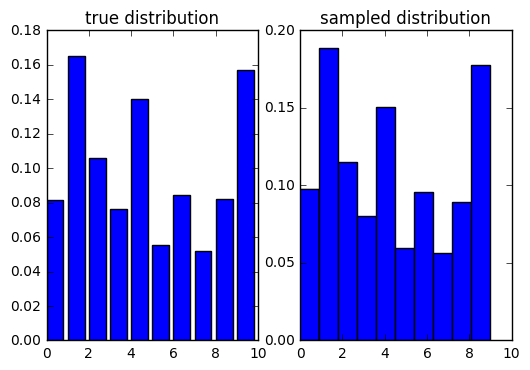采样方法总结:Alias method

之前做的论文中,有一处关键的计算涉及到对一个高维度的离散分布求数学期望,这个问题本来可以简单地sum over这个概率分布的support解决,然而这个方案被reviewer质疑运行速度太慢,于是又想出一招用alias method做Monte Carlo采样算积分。用了采样以后程序变得更容易并行化,用C写了下效率大增。由于网上已经有相当多介绍alias method采样方法的文章了,其中不少还非常详细,我再写一遍也不过鹦鹉学舌,因此本文只对实现方法作简单记录。
相关链接:
一个国外大神写的文章,介绍非常详细:Darts, Dice, and Coins;
一篇讲得简单清晰的中文文章:【数学】时间复杂度O(1)的离散采样算法-- Alias method/别名采样方法;
C++实现:https://oroboro.com/non-uniform-random-numbers/;
各种离散采样方法的实验比较:回应CSDN肖舸《做程序,要“专注”和“客观”》,实验比较各离散采样算法 - Milo Yip - 博客园;
Naive Implementation:
最早写的这个版本应该是网上所有alias method实现里代码量最少,也最简单暴力的版本了,虽然复杂度并不是最优。
注意:
- 为了方便在Python中调用,这里把生成alias table的过程写在cpp中,在Python里用numpy的C++接口调用cpp;
- 因为这个实现过于简单暴力,两种情况下代码会死循环,第一是输入的pdf不合法的情况,即pdf向量中所有元素加起来不等于1.0,第二是浮点数精度不足带来的条件判断不通过问题,这里的代码在我的电脑上运行良好;
用shell(或用 python 调shell )跑咩?
// TO COMPILE sampler.cpp into sampler.so:
// g++ -std=c++11 sampler.cpp -o sampler.so -shared -fPIC -O2 -D_GLIBCXX_USE_CXX11_ABI=0
extern "C" {
/**
* @brief Generate an alias table from a discrete distribution
* @param out An array of size 2 * length, representing the alias table
Note that this array should be 1.0 in each column after the function
**/
void gen_alias_table(float* out, int* events, int length) {
int more, less, flag;
while (true) {
flag = 1;
for (int i = 0; i < length; i++) {
if (out[i] + out[i + length] < 1.0) {
less = i;
flag = 0;
break;
}
}
for (int i = 0; i < length; i++) {
if (out[i] + out[i + length] > 1.0) {
more = i;
flag = 0;
break;
}
}
if (flag)
break;
out[less + length] = 1.0 - out[less];
out[more] = out[more] - 1.0 + out[less];
events[less + length] = more;
}
}
} // extern "C"Python部分实现如下:
# utils.py
import numpy as np
import ctypes as ct
class discreteSampler(object):
def __init__(self, probs):
'''
This class can sample from high dimensional discrete distribution using the Alias method
For better efficiency, the generation of alias table is implemented with C++
:param probs: a 1 dimensional numpy.ndarray representing the PDF for the discrete distribution
'''
length = probs.shape[-1]
self.probs = np.copy(probs)
self.alias = np.zeros((2, length), dtype=np.float32)
self.alias[0, :] = self.probs * length
self.events = np.ones((2, length), dtype=np.int32)
self.events[0, :] = np.arange(0, length, dtype=np.int32)
self.events[1, :] = -1.0
# Load and run the C++ dynamic library
BASE_DIR = os.path.dirname(os.path.abspath(__file__))
self.dll = np.ctypeslib.load_library(os.path.join(BASE_DIR, 'sampler.so'), '.')
self.dll.gen_alias_table(self.alias.ctypes.data_as(ct.c_void_p),
self.events.ctypes.data_as(ct.c_void_p),
ct.c_int(length))
def generate(self):
idx = random.randint(0, self.probs.shape[-1] - 1)
if random.uniform(0.0, 1.0) <= self.alias[0, idx]:
return idx
else:
return self.events[1, idx]最后用随机数测试下,采样10000次,可视化。
# Testing the sampling using the alias method implementation
import numpy as np
import utils
import matplotlib.pyplot as plt
probs = np.random.uniform(0.0, 1.0, [10])
probs /= np.sum(probs)
idxs = np.arange(0, 10)
sampler = utils.discreteSampler(probs)
collect = list()
for it in range(10000):
collect.append(sampler.generate())
plt.figure()
plt.subplot(121)
plt.bar(idxs, probs)
plt.title('true distribution')
plt.subplot(122)
plt.hist(collect, bins=10, normed=True)
plt.title('sampled distribution')
plt.show()运行结果:
